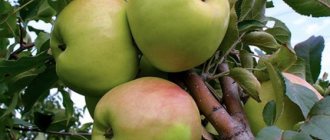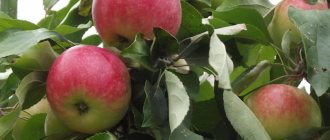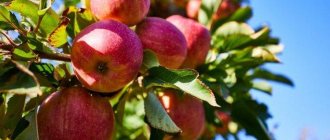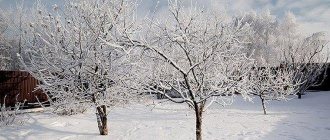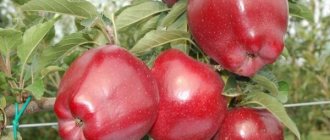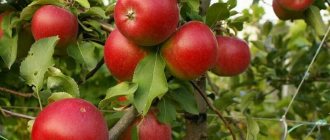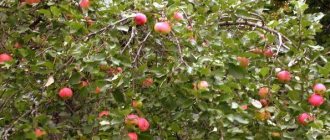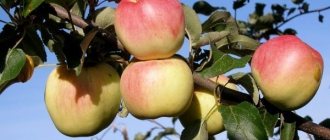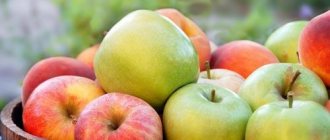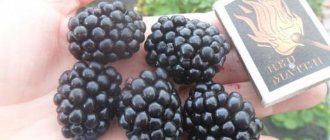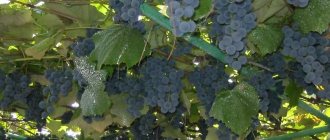Main characteristics
All varieties of winter apples are shelf-stable. They can retain their external and taste characteristics until spring, and some varieties can last until summer. Such fruits do not lose either smell or taste if stored correctly. They are usually harvested in late September or early October. During this period, apples contain a lot of protein and starch.
Fruits are considered fully ripe several months after harvest. The average shelf life is 3–7 m. There are early winter, winter and late winter varieties.
The main difference between winter varieties and summer ones is that such apples must sit for at least a month before consumption.
Below is a description of the most popular types of winter apples.
Idared
The first color of the variety is green, but quickly turns yellow and red. The pulp is dense and juicy. This variety is rarely susceptible to brown spot, but is often affected. Idared apples can be eaten both fresh and processed as purees, juices, dried fruits or compotes.
| Fruiting | Tree height (m) | Fruit weight (g) | Harvesting | Storage (days) |
| 5–6 year | 2–3 | 150–200 | end of September | 150–180 |
Antey
Late variety, bred in the Republic of Belarus. Resistant to frost, able to withstand fairly cold winters. This is a sweet winter apple variety, it is very juicy and retains its natural aroma for a long time. During ripeness, the green fruits become bright red and even burgundy. Due to the waxy coating they may appear bluish. After harvesting, at least 2 months must pass. They are used both fresh and processed.
| Fruiting | Tree height (m) | Fruit weight (g) | Harvesting | Storage (days) |
| 2–3 year | 2-2,5 | 180–200 | September October | 200–240 |
Bogatyr
This late-winter variety grows well in any climatic conditions. The fruits are strong and taste sweet and sour. If storage conditions are met, they can last until summer. Apples remain green until harvest. Then they turn yellow and may turn a little red. This variety bears fruit well, is resistant to diseases and is easily transported due to its properties. They retain the marketable appearance of the fruit for a long time.
| Fruiting | Tree height (m) | Fruit weight (g) | Harvesting | Storage (days) |
| 5–6 year | 2–3 | 150–190 | end of September | 150–180 |
Jonathan
The soil for this variety should be rich and very moist. The fruits have a good taste and ripen with a red tint. The trees are resistant to scab and powdery mildew.
| Fruiting | Tree height (m) | Fruit weight (g) | Harvesting | Storage (days) |
| 4–5 year | 2,5-3 | 110–150 | mid September | 150–180 |
Lobo
Removed from Macintosh. Inherited the taste and rich color. The harvest is annual and good. Trees withstand winter and drought. They have average immunity to diseases.
| Fruiting | Tree height (m) | Fruit weight (g) | Harvesting | Storage (days) |
| 4–5 year | 3–4 | 100–200 | from late September to early October | 150–180 |
Mac
This variety was bred in Canada. The fruit has a yellowish tint or dense green color. Dark red or slightly purple streaks may be visible. Ripens 2–3 weeks after harvest. Apples taste sweet. The variety is moderately resistant to frost and often gets sick. This is a fairly popular winter apple variety.
| Fruiting | Tree height (m) | Fruit weight (g) | Harvesting | Storage (days) |
| 6–7 years | up to 4 | 150–180 | September October | 150–180 |
Red Delicious
The tree is not impressive in height. A growing apple tree has a crown shaped like an inverted triangle. Afterwards it grows and becomes round. Ripe fruits have a rich red color. From the name it is clear that they taste sweet, the distinctive feature is that you can feel a little iron. Apples store well and withstand shipping, but may be susceptible to bitter spot. Due to their appearance and taste, these winter varieties of red apples are considered one of the most popular among consumers.
| Fruiting | Tree height (m) | Fruit weight (g) | Harvesting | Storage (days) |
| 3–4 | 3–4 | 200–250 | at the end of September | 180–220 |
Renet Simirenko
The variety has a mixed type of fruiting. The trees are taller than average and have good resistance to wind and drought. The fruits are medium or large, the main color is green. Small formations on the surface of the apple are considered a feature and are not a defect. The pulp is rich white in color, juicy, and has a spicy wine flavor. The origin of this green winter apple variety is unknown.
| Fruiting | Tree height (m) | Fruit weight (g) | Harvesting | Storage (days) |
| 4–5 year | 6–7 | 140–170 | September October | 230–250 |
Sinap Orlovsky
This is a late winter variety with large trees. The fruits are large, the size is almost the same. The main color is green, a red blush may appear. The pulp has a sweet and sour taste. The main condition for good growth is the presence of calcium in the soil.
| Fruiting | Tree height (m) | Fruit weight (g) | Harvesting | Storage (days) |
| 4–5 year | 6–8 | 130–150 | end of September | 200–240 |
Winter varieties of apple trees
Idared
Late winter medium height. The apples have a conical appearance with rounded ribs, the mass of the apple is 150-190g. The main color of the fruit is green, the top color is a reddish blush. The structure is dense, the taste is juicy, sweet and sour.
Moderately resistant to scab. It begins to bear fruit 5-6 years after planting. Harvesting is carried out at the end of September and stored until mid-spring.
Idared.
You can see detailed photos and descriptions of the Idared variety here.
Antey
Late winter sweet variety. The trees reach a height of 2-2.5 m.
The fruits are juicy, weighing 180-200g, have dense, homogeneous pulp. Apples are very fragrant. They are collected in early October. When ripe, they acquire a burgundy or dark red color.
The fruits are stored until April. Apple trees have good resistance to low temperatures.
Antey.
You will find more information about the Antaeus apple tree here.
Alesya
Late winter , reaching a size of 3.5-4.0 m in height. The variety is early-bearing and begins to bear fruit at the age of 3-4 years. Apple tasting score: 4 points. The apples are sweet and sour, juicy, weighing 150-200g with a weak aroma and a fine-grained structure.
It is characterized by high productivity, regularity of fruiting, resistance to scab and adverse weather conditions. It is grown mainly on medium-sized rootstock. Stored until May.
Alesya.
You will learn more about the Alesya apple tree from this article.
Antonovka
Early winter variety of ancient selection. The tree is mostly tall, but can also be medium-sized. The growth of the tree on a low-growing rootstock is 3.0-4.0 m, on a seed rootstock - 4.0-6.0 m. The plants have a wide crown, the branches are thick and strong. On a short rootstock it quickly begins to bear fruit.
The pale green main color of the fruit becomes light yellow when fully ripe. Fruit weight -150-170g. The sweet and sour taste of apples has a unique wine aroma. Stored until mid-December. The pulp is juicy, dense, granular, and loosens during long-term storage.
The predominance of acid in the taste allows it to be used in cooking and soaking apples.
It is a good pollinator for other varieties.
Antonovka.
You can read more about the Antonovka apple tree here.
Belarusian synap
Late winter variety. The medium-sized plant reaches a height of 2-2.5 m. The crown is pyramidal, not thickened. Begins to bear fruit in 2-3 years.
Apples weighing 200-250 g have a sweet and sour taste with a pleasant juicy texture and delicate aroma. The fruits are stored until the new harvest.
Belarusian synap.
Bogatyr
The variety belongs to late winter . The taste of apples is sweet and sour. The fruits are firm, crispy, strong and aromatic. The color is light green, during storage it turns yellow or acquires a faint blush.
Advantages:
- Winter-hardy;
- Drought resistant;
- Scab resistant;
- Harvest;
- Has a good presentation;
- High transportability.
Main characteristics:
- Tree growth - 2-3 m;
- Entry into fruiting - 5-6 years;
- Apple weight - 150-190 g;
- Harvest period: end of September;
- The shelf life of apples is until March.
Bogatyr.
You will find more information about the Bogatyr apple tree here.
Golden Delicious
Late winter variety. Cultivated with medium-growing and vigorous rootstocks. The growth of a tree on a low-growing rootstock reaches 2.0-3.0 m, on a vigorous rootstock - 4.0-6.0 m. It begins to bear fruit on a low-growing rootstock in 2-3 years, on a vigorous rootstock - in 5-6 years. The crown of the tree is wide and dense. A pollinator variety is required.
It has an excellent sweet taste, which does not deteriorate with long-term storage. Apples weighing 150-200g have a slightly oblong shape and a golden color. The pulp is juicy, crispy, the skin is dense but thin, and is resistant to mechanical damage.
Resistance to low temperatures is high, transportability is good, susceptible to damage by powdery mildew and brown spot. Apples are harvested in September and stored until mid-spring.
Golden Delicious.
You will learn more about the Golden Delicious apple tree from this article.
Darunak
Late winter variety. The fruits are an attractive purple color with a thin, elastic skin, slightly asymmetrical, with slight ribbing. The taste is pleasant, delicate, sweet and sour. Good resistance to low temperatures, high resistance to scab and natural unpretentiousness, ease of care are its advantages.
Main characteristics:
- Tree height - 3.5-4 m;
- Entry into fruiting - 3-4 years;
- Apple weight - 120-160 g;
- Harvest period - late September - early October;
- The shelf life of apples is until March.
Darunak.
You can read more about the Darunak apple tree here.
Jonathan
Late winter apple variety of North American origin. Its other names: Osmalovskoe, Khoroshavka winter, Winter red.
The tree is medium-sized, 2.5-3.0 m high. Prefers fertile, well-moistened soils. Has good resistance to scab and powdery mildew.
The fruits are juicy, dense, weighing 150-190g, by the end of ripening they acquire a red blush, have a sweet and sour taste and a faint spicy aroma. Tasting score -4.5 points. The fruits are stored until March.
Jonathan.
Read more about the Jonathan apple tree in this article.
Lobo
An early winter variety with excellent taste characteristics. It has high productivity and annual fruiting. Advantages include drought resistance and winter hardiness. The fruits are juicy, dense, round, weighing 100-180 g, rich red.
Main characteristics:
- Tree height - 3.4-4.0 m;
- Beginning of fruiting - 4-5 years;
- Harvest period - late September - early October;
- The shelf life of apples is until January.
Lobo.
You can find more information about the Lobo apple tree here.
Mac
Early winter sweet variety. The main color is light yellow, covered with purple or dark red stripes on top. Ready for use a couple of weeks after picking. The trees have average winter hardiness and are susceptible to fungal diseases.
Main characteristics:
- Tree growth - 3.5 - 4.0 m;
- Entry into fruiting - 150-180 g;
- Harvest period - late September - early October;
- The shelf life of apples is until January.
Mac.
You will learn more about the McIntosh apple tree variety from this article.
Pepin saffron
The oldest, most popular late-winter variety in the Russian Federation. Productivity is high, but fruiting in adulthood is periodic. It begins to bear fruit after 5-6 years.
The apples are quite small, weighing 70-80 g, strong, and have an elongated, ovoid shape. They are ruddy on top, and the main color is light green. The taste of the fruit is sweet and the aroma is spicy, with a wine aroma.
Winter hardiness and disease resistance are average. Recovers quickly from damage. The crop is harvested at the end of September - beginning of October and stored until March.
Pepin saffron.
You can read more about the Pepin saffron apple tree variety here.
Red Delicious
A medium-sized winter apple tree, reaching a size of 4.0-6.0 m. The crown is wide, slightly pyramidal, and its fruits are large in size. Product quality is high, transportability is good.
Apples are prized for their sweet taste. The bright red color of the fruit attracts the attention of consumers. The harvesting period is September-October. The shelf life of apples is until February.
Red Delicious.
Read more about the Red Delicious variety in this article.
Northern synapse
Late winter variety with a wide, powerful, pyramidal crown. Tree of medium height . High yield, average drought resistance and scab resistance are the advantages of the variety. In addition, Northern Sinap is a winter-hardy variety of apple trees. Harvesting maturity occurs relatively late - by early October.
Advice! Unripe apples do not provide high taste, so harvesting must be done when the fruits acquire a beautiful appearance and a ruddy outer color and are fully ripe.
Main characteristics:
- Tree growth - 4.0-6.0 m;
- Beginning of fruiting - 6-8 years;
- Apple weight - 120-170 g;
- Harvest period - late September - early October;
- The shelf life of apples is until April.
Northern synapse.
You will find more information about the Northern Sinap apple tree here.
Sinap Orlovsky
Winter variety , with a tall, wide crown reaching 3.0-4.0 m. The fruits are green with a slight blush, large, weighing 200-250 g, of the same size, have a good presentation. The pulp is dense, juicy, sweet, with a slightly detectable sourness.
It has good resistance to difficult weather conditions and diseases. The harvest is harvested at the end of September and stored until March.
Sinap Orlovsky.
You will learn more about the Sinap Orlovsky apple tree variety from this article.
When to collect winter apples for storage?
Their taste and external qualities depend on whether the apples were picked on time. All varieties in this category ripen already during storage under certain conditions. Except in cases where climatic factors influence the deadlines, they are observed quite strictly.
When to harvest winter apples is on average between September and October. During this period, the fruits contain a lot of starch, they are hard and sour. Apples become juicy and sweet, turn red and acquire the desired color and pronounced aroma when 2–3 months pass after picking. In some cases, the gardener begins harvesting earlier if the autumn weather fails.
The harvest time for winter apple varieties is affected by summer weather. During the hot season, ripening occurs faster, and vice versa. In addition, experts highlight the main signs that it is time to pick the fruits:
- size;
- age;
- color;
- pulp density;
- starch content.
When the time is right, the apples are easily separated from the branch. In windy weather, fallen fruits can be seen under the tree. The seeds should be dark brown in color and the flesh will be firm and sour. The timing of harvesting winter apple varieties differs depending on the growing region. Harvesting before the minimum is not recommended. How to preserve fruits. During ripening, they can be damaged due to adverse weather conditions or falling from a branch.
General properties of late varieties of apple trees
According to most experts, late autumn and winter varieties of apple trees in a home garden should make up at least 60% of all trees belonging to this crop . Of course, on 6-8 acres (and there are many such summer cottages in our country) it is difficult to place a large number of different apple trees, but at least one of them must produce long-lasting fruits. Summer apples are not suitable for this purpose: they usually have tender, perishable pulp and thin skin, and can only be enjoyed for a few weeks after picking.
The harvest of summer apple trees, as a rule, is not stored for more than a month. During this time it must be eaten or processed
Varieties of crops classified as “winter” have the following features :
- The harvest reaches harvest ripeness by early September - late October (depending on the variety and region of cultivation).
- In most cases, fruits just picked from the tree do not fully possess the consumer qualities characteristic of the variety. The taste and aroma finally “reveal” after several weeks or even months of storage.
- Apples have dense pulp and durable skin. When carefully collected and stored under optimal conditions, they do not deteriorate for 4-5 months, and some for more than six months.
- The purpose of the fruit is universal. They are suitable both for fresh consumption and for the industrial production of sweets and juices, as well as for home canning, drying and freezing.
How to store winter varieties of apples?
Before being collected for storage, fruits always undergo preparation and pre-selection. Wooden containers are considered the most convenient for installation. Before distribution, apples are selected according to:
- size;
- shelf life;
- presence of defects;
- the presence of a stalk.
Experts do not recommend leaving picked fruits outdoors for a long time.
Long-term storage of apples is achieved at a temperature of 2–5 degrees. Humidity is of great importance - 85–90%. If its indicator is low, the fruits will quickly wrinkle and wither. The room in which you plan to store apples must be pre-processed and cleaned; other fruit and vegetable crops should not be stored in it.
The best varieties of winter apples for different climates
Before planting, the farm always conducts a soil study, analyzes average climatic and weather indicators, including precipitation and temperature changes, and determines which apple trees will bear fruit better. The most popular varieties are those that can resist diseases, produce large yields, regardless of soil quality, and withstand long winters with severe frosts. For example, not everyone will choose the Antonovka variety, since its harvest is inconsistent.
Each climate zone has its own recommendations. In addition, farmers often create greenhouse conditions in the garden, in which they can grow even apples that cannot withstand too much frost.
Below are recommendations for growing specific varieties of winter apples by region.
| Region | Variety |
| Central Russia | Lobo, Imant, Bylina |
| Moscow region | Renet Chernenko, Vesalina, Rashida |
| Leningrad region | Antey, Ladoga, Druzhnoe |
| Ural and Siberia | Amber, Vem pink, Cherished |
| Belarus | Antey, Pospeh, Belana |
| Volga region | Sinap Orlovsky, Scarlet Anise, Star |
| Ukraine, Southern Russia | Idared, Jonathan, Renet Simirenko |
